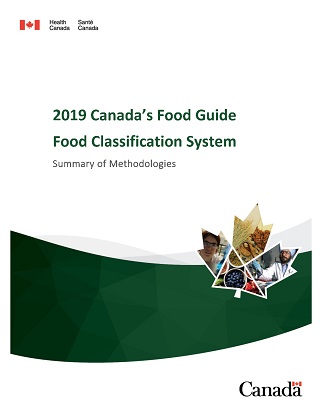2019 Canada’s Food Guide Food Classification System: Summary of methodologies
Download in PDF format
(1.19 MB, 4 pages)
Organization: Health Canada
Date published: September 2022
Background
To support researchers and nutrition professionals in performing consistent assessment of food intake alignment with the 2019 Canada’s Food Guide (2019 CFG), HC designed the 2019 Canada’s Food Guide Food Classification System (2019 CFG-FCS). This surveillance tool classifies foods found in the Canadian Nutrient File (CNF), Canada’s standard reference food composition database, into categories and tiers based on their alignment with the 2019 CFG.
Following the launch of the 2007 Canada’s Food Guide (2007 CFG), Health Canada (HC) developed a surveillance tool to assess Canadians’ food intake according to the 2007 CFG guidanceFootnote 1. The 2007 food classification system assigned foods found in the CNF, to one of four tiers according to how closely they align with the 2007 CFG. It was referred to as the “CNF/CFG Classification” or the “Health Canada Surveillance tool”.
The 2019 CFG-FCS is an update of this classification system.
To further assist nutrition researchers, HC has made available 2019 CFG-FCS files on Open Government and on the Publications – Food and nutrition - Canada.ca website.
Short description
The 2019 CFG-FCS was developed and validated by HC. It is an update of the 2007 CNF/CFG Classification. In summary, food groups from the 2007 CFG classification were modified to align with the 2019 CFG and the following tiers were created:
- Tier 1: Foods encouraged by Canada’s Food Guide i.e. Foods that contain little to no added sodium and saturated fat and little to no free sugars.
- Tier 2: Foods that do not meet requirements for Tier 1 or Tier 3.
- Tier 3: Foods that should not be consumed regularly i.e. Foods that contribute to excess consumption of sodium, saturated fat or free sugars.
Information available on Publications
(Also available in pdf format.)
Description of how foods are assembled and what codes are used to identify the categories.
- High-level categories, the most general category, contain one digit.
- Mid-level categories contain two digit codes.
- Low-level categories, the more specific categories, are identified by three digit codes.
Presentation of the methods used by Health Canada to develop and validate the 2019 Canada’s Food Guide Food Classification System.
2019 Canada’s Food Guide Food Classification System: Development and validation
Files available on Open Government
File name: CNF-FCÉN & Class.xlsx
- Contains all foods from version 2015 of the CNF as well as Nutrition Survey System (NSS) recipes along with their assigned tier. Note that NSS recipes made from ingredients that belong to more than one food category are excluded from the file.
- Two tiers are provided for each food:
- The first tier, found in column CLASS, is determined based on the food nutrient profile without any cooking.
- For select animal-based proteins that are often consumed cooked, the second tier, found in column CLASSR (tier with replacement) is assigned based on the nutrient profile and reference amount (RA) of the cooked version of the food. The cooked version usually being broiled or baked i.e. a cooking method without the addition of much fat.
This additional tier with replacement is provided since many of the raw versions are not in fact consumed raw. Depending on the research question and the survey being used, it may be more desirable to use column CLASSR.
In other words, the value of CLASSR is equal to the tier of the cooked equivalent for that food.
- Note that the 2019 CFG-FCS assigns tiers to all CNF foods with the exception of the following food categories for various reasons such as missing data, products being targeted to specific populations or in a form that requires reconstitution as well as recipe made from ingredients that belong to more than one food category:
- 8100: Baby and toddler foods
- 8200: Meal replacements and supplements
- 8300: Alcohol beverages
- 8400: CNF recipes
- 8500: Miscellaneous foods
- 9990: Unclassified foods and beverages (due to missing data)
File name: Data Dictionary - Dictionnaire de données.txt
Contains the meaning of column headers and information on codes used in the CNF-FCÉN & Class.xlsx file.
Footnotes
- Footnote 1
-
Health Canada. Eating Well with Canada’s Food Guide. Available at: https://www.canada.ca/en/health-canada/services/canada-food-guide/about/history-food-guide/eating-well-with-canada-food-guide-2007.html
Accessed July 16, 2021.
